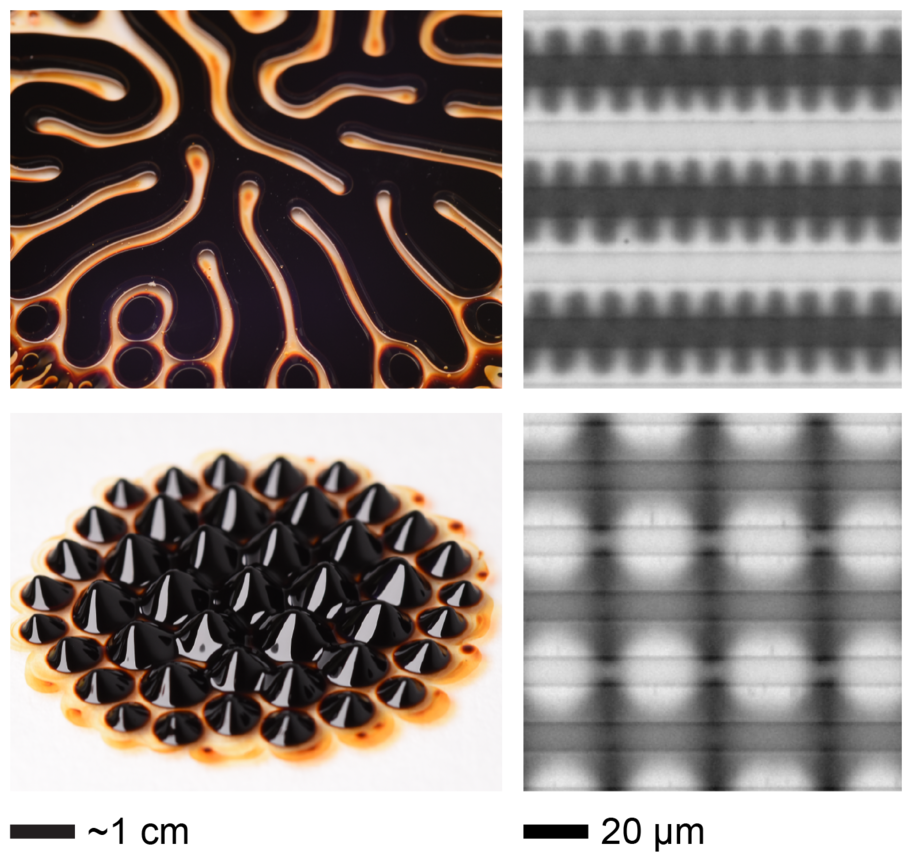A nanoparticle suspension could act as a simple model to investigate the formation of patterns and structures in highly complex non-equilibrium systems like cells, report scientists from Aalto University.
 Photographs and micrographs showing the various patterns exhibited by the electroferrofluid: equilibrium patterns in magnetic field only (left) and non-equilibrium patterns created under a combination of electric and magnetic fields (right). Image Credit: Active Matter research group led by Prof. Timonen/Aalto University
Photographs and micrographs showing the various patterns exhibited by the electroferrofluid: equilibrium patterns in magnetic field only (left) and non-equilibrium patterns created under a combination of electric and magnetic fields (right). Image Credit: Active Matter research group led by Prof. Timonen/Aalto University
Besides serving as a valuable tool for analyzing patterning processes, the new system could also find an extensive range of prospective technological applications.
The mixture includes an oily liquid with iron oxide, and the nanoparticles turn magnetized under a magnetic field. When a voltage is applied across this ferrofluid under suitable conditions, the nanoparticles tend to migrate and develop a concentration gradient within the mixture.
To achieve this effect, it was necessary for the ferrofluid to also contain docusate—a waxy chemical with the ability to carry charge through the fluid.
The team found that the occurrence of docusate and a voltage across the ferrofluid led to the separation of electric charges, where the iron oxide nanoparticles turned negatively charged.
We didn’t expect that at all. We still don’t know why it happens. In fact, we don’t even know whether the charges already get split when the docusate is added or if it happens as soon as voltage is turned on.
Carlo Rigoni, Postdoctoral Researcher, Aalto University
The researchers dubbed the fluid an electroferrofluid rather than just a ferrofluid to emphasize its novel sensitivity to electric fields. Thanks to this electrical responsiveness, the nanoparticles migrate, and the ensuing variations in nanoparticle concentration alter the electroferrofluid’s magnetic responsiveness.
Thus, when a magnetic field is applied across the electroferrofluid, the distribution of the nanoparticles is altered based on the strength and orientation of the magnetic field.
Put differently, the nanoparticle shifts from one state to another under the influence of a small change in the external magnetic field distribution—that is, it is unstable. The blend of docusate and voltage converted the fluid from an equilibrium system into a non-equilibrium system that needs constant input of energy to preserve its state stable—a dissipative system.
Due to these unpredicted dynamics, electroferrofluids are specifically intriguing scientifically and in relation to their prospective applications.
Ferrofluids have drawn the attention of scientists, engineers and artists since their discovery in 1960s. Now, we have found a truly facile approach to control their magnetic properties on-the-fly just by applying a small voltage to drive the fluid out of thermodynamic equilibrium.
Jaakko Timonen, Professor of Experimental Condensed Matter Physics, Aalto University
“This allows a completely new level of control of the fluid properties for technological applications, complexity in the pattern formation, and perhaps even new artistic approaches,” added Timonen, who supervised the study.
“Dissipative driving is the general mechanism creating the patterns and structures all around us,” added Rigoni. “Life is an example. Organisms have to continually dissipate energy to their ordered state, and that’s also true for the vast majority of patterns and structures in ecosystems.”
According to Rigoni, the findings offer a valuable model system for researchers attempting to gain insights into dissipative systems and their underlying pattern formation, whether in the form of complex non-living systems or living organisms.
Most dissipative systems are very complex. For example, it’s very hard to reduce living structures to a set of simple parameters which could explain the emergence of certain structures.
Carlo Rigoni, Postdoctoral Researcher, Aalto University
Researchers can use the voltage-driven ferrofluid to analyze the shift into a dissipative system and perceive how external impacts, for example, a magnetic field, interact with the system to produce or alter structures. “This could give us hints about how dissipative structures in more complex contexts are created,” Rigoni added.
Apart from its value in basic research, the finding could also find potential practical applications. The potential to manipulate the pattern and distribution of nanoparticles is very useful in various technologies, like e-ink screens and optical grids. Moreover, this technique's very low power consumption makes it specifically attractive.
“This initial research was mainly about the basic science, but we’ve already started work that focuses on applications,” Rigoni concluded.
Journal Reference:
Cherian, T., et al. (2021) Electroferrofluids with non-equilibrium voltage-controlled magnetism, diffuse interfaces, and patterns. Science Advances. Available at: https://www.science.org/doi/10.1126/sciadv.abi8990.